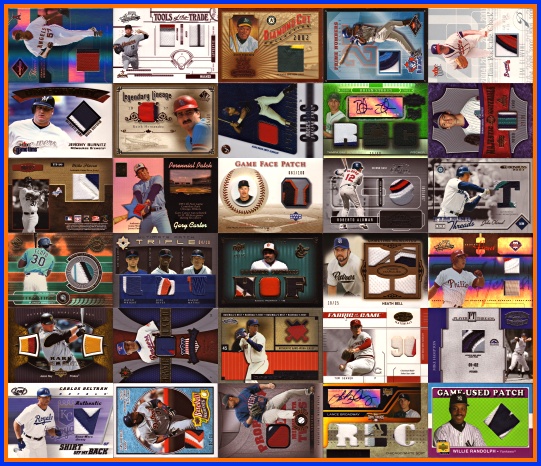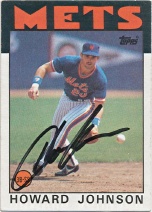Baseball cards and traditional media, pot and kettle?
In Part 1, I looked at the factors that I saw playing a part in the success or failure of the baseball card industry. I wrote this without having seen the CBS News piece that has stirred up this discussion over at Beckett, Panini, Upper Deck, and Cardboard Connection. To me, the health of the hobby comes down to interest in the sport, innovation in the industry, and cost. Cost is the tricky one.
Today’s baseball card market looks nothing like it did 25 years ago. There are far more choices, a higher barrier to entry, a much wider spread between low-end and high-end, and a lot more baggage from years past. As I’ve lamented here, the small local card shows are largely a thing of the past. Even the regular mall shows are slowing down with eBay providing a much better option for buying and selling the kind of merchandise that pays the bills. Way back in 2000, I was at a mall show and saw a 2000 UD Legends Gary Carter Gold Autograph that would have been perfect for my then-fledgling Mets autograph collection. When I asked if the price was flexible, the dealer just asked if I was on eBay. Since I was, he said that we wouldn’t be able to make a deal. He just couldn’t compete with a global marketplace and wasn’t even going to try, instead opting to put his effort into selling to people who hadn’t yet gotten with the times. His market was dwindling and he knew it; it was just a matter of time before the old ways would no longer be viable.
The dealers I met during my third life as a card collector (2000-2003) were a much different breed from the ones back in the ’80s and ’90s. As with my local shop owner from the ’80s, these dealers had largely abandoned the storefront and now dealt in cards as a side business out of their homes, loading up their cars one weekend a month to set up a few tables in a mall and make deals with the ranks of the nostalgic and the faithful. They could cut you a deal on a complete 1978 Topps set or the Lenny Dykstra rookie that was inexplicably missing from your 1986 Topps set. They would gladly take any cards of local interest for trade or credit and would talk sports or cards with you when things slowed down. It was a support group for people trying to figure out how to cope with the changes in the hobby.
And that brings us to the CBS piece. The hobby is dying. A weekly local card show filled with ’70s Topps cards isn’t drawing in the kids. Cards are too expensive. Kids are only interested in video games and computers and girls. Times are tough for a celebrity card dealer who used to be rolling in cash. Give me a freaking break.
You know, we had video games, computers, and even girls (well, that one’s a bit of a stretch, for me at least) back in the ’80s. We didn’t have global networks and smartphones, but things haven’t changed that much on the “how kids spend their free time” front. The biggest change has been the social aspect – the Internet-connected game consoles and smartphones are bringing kids together like never before. Even the anime-inspired trading card games of the ’90s (and still going strong today) emphasize the social aspect of cards. What about baseball cards?
The appeal of baseball cards has been constantly changing since the mid ’80s. First popular for pictures of players and listings of stats, cards became seen as a viable investment as prices of older (and much scarcer) cards went through the roof. Baseball cards had gone from a novelty to a collectible, which can be a dangerous shift. When collectibles become self-aware, greed can bring about self-inflicted ruin. Overproduction made just about everything from this boom period worthless and created the unrealistic expectations that served as the point of comparison in the CBS report.
But who cares about what the market did ages ago? The rise of inserts and premium sets shifted the focus from sheer numbers to diversity. Upper Deck was premium from its start in 1989. Leaf went premium in 1990. Fleer and Topps launched premium lines in 1991. Bowman and Donruss went premium in 1992. Fleer, Topps, and Upper Deck launched super premium lines in 1993. Upper Deck went premium again in 1994. It was a never-ending escalation. Kids were priced out of the market.
The reality was that pack prices were always rising. The premium craze sped things up and undoubtedly pushed out the indifferent collector, but experiments in low-price alternatives like Triple Play and Collector’s Choice proved an important point – the market wanted a quality product. It wasn’t a market that catered exclusively to kids, and certainly the proportion of kids to adults had changed, but what could be done? Can you force a market to reduce profits just to match your nostalgic view of how things should be?
Maybe I just don’t get it because my nostalgia doesn’t fit the narrative. I knew very few card collectors when I was a kid and most of them were into higher-end products than I could afford. I was priced out of the market. And yet I still bought lots of cards until other obligations took over my time and attention, sampling most of the premium and super premium lines along the way (and now wishing that I had focused on quality over quantity). Have the demographics really changed all that much in 20 years?
And this is where I’m as lost as you are reading it. I’ve tried to touch on all of the factors that play into the success and failure of baseball cards. CBS showed how things are different now compared to an unrealistic bubble economy. I’ve painted a complex picture of an industry with many facets. CBS showed two very limited data points. I see uncertainty with signs pointing to at least modest success. CBS showed certain doom. I suppose I shouldn’t be surprised though, CBS produced a 5 minute fluff piece while I tried to capture the history of an industry and my connection to it. Reality often fails to fit into a convenient narrative.
Why even bother running a piece on an industry just to say “it’s doomed” and not even bother to back it up? Why not look at the tragic end of Upper Deck as a fixture in the hobby or Panini’s clumsy revival of the Playoff/Donruss brand? Why not point out the inherent irony in MLB Properties granting Topps a monopoly to encourage innovation? Of all the signs of the hobby’s impending demise they could have chosen, CBS went to the local interest well for a bunch of guys who are about as out of touch with the hobby as the reporters themselves. That’s the sign of an industry on the brink of failure.
I really don’t know what the future holds for the baseball card industry. And I don’t know if that future even matters to collectors, whatever it might hold. Collectors will continue no matter what happens in the industry, changing their focus to keep the hobby interesting, taking a break when they need to, and eventually coming back if and when they see a future in the hobby. I’ve been in and out of this hobby so many times that I barely recognize what I was in my previous incarnations. I look at cards that have no place in my collection now but were centerpieces once upon a time; I see others that mean far more to me now than they did years ago. Most of all though, I see this hobby’s past as being something that is rich for mining, with every new set adding to the diversity of a mosaic that is too great to be seen in whole. The totality of the hobby is not in the current month’s or year’s offering, it is in all of the products and collectors that have come before. The hobby is bigger than any one product, manufacturer, collector, or card show. The hobby is bigger than eBay, Beckett, or even the entire Internet. The hobby will live on long after cards stop being produced or games stop being played.
Now about that stack of 1975 Topps in the CBS piece, could someone check it against my wantlist? I really need to get working on that set…



Recent Comments